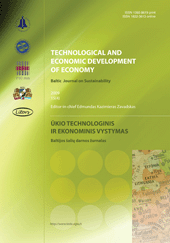Evaluating Situation of Lithuania in the European Union: Structural Indicators and MULTIMOORA Method
Evaluating Situation of Lithuania in the European Union: Structural Indicators and MULTIMOORA Method
Author(s): Alvydas Baležentis, Romualdas Valkauskas, Tomas BaležentisSubject(s): Economy
Published by: Vilnius Gediminas Technical University
Keywords: multi-objective optimization; MOORA; MULTIMOORA; structural indicators; Lisbon Strategy; strategic management; sustainable development; European Union; international comparison
Summary/Abstract: According to the Lisbon Strategy, which was adopted in 2000, the European Union (EU) should become the most competitive region in the World. Goals, defined in the strategy, and instruments for seeking them are identified by structural indicators as well as their systems. It is possible to evaluate specific country’s situation and compare it with other countries by using various specific indexes or applying statistical – mathematical methods. The aim of this article is to describe main structural indicators, which identify the implementation of Lisbon Strategy as well as progress in sustainable development and to evaluate Lithuania’s and other Baltic States’ position in the EU using statistical methods. In order to achieve this aim, the following tasks were raised: 1) to describe and classify structural indicators; 2) to overview main methods of quantitative analysis and to apply them when evaluating Lithuania’s and other Baltic States’ position in the EU. Lithuania’s progress in achieving Lisbon Strategy goals was evaluated using the system of 13 shortlist structural indicators from Eurostat database and applying MULTIMOORA (Multi-Objective Optimization by Ratio Analysis plus Full Multiplicative Form) method. The analysis showed that Lithuania is among top EU countries by such indicators as employment rate, youth education attainment rate, comparative price level and greenhouse gas emission. Thus there are no serious environmental problems in Lithuania and its production can successfully compete at international markets due to relative low production costs. Lithuania is backward by GDP per capita, labour productivity and employment rate of older workers. In addition, energy intensity of the economy needs to be optimized. Considering all the above, technologic backwardness is characteristic for Lithuania’s industry (due to low labour productivity on the one hand and high energy intensity on the other) which can be eradicated by encouraging innovations and R&D activities. Baltic region is quite homogenous in innovation and research as well as in economic reform areas, thus it can become attractive for investors. Lithuania and Estonia could be assigned to medium performance group and Latvia is on the very limit of the low performance group.
Journal: Technological and Economic Development of Economy
- Issue Year: 2010
- Issue No: 4
- Page Range: 578-602
- Page Count: 25
- Language: English

